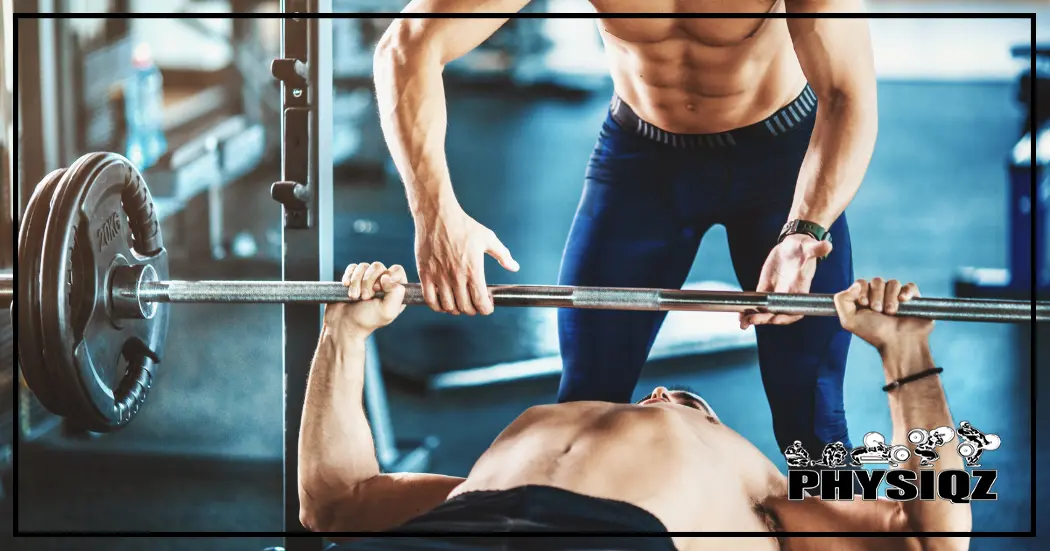
Understanding that the bar should not touch the chest can assist gym-goers who incorrectly place it too high or too low, as seen in some powerlifting techniques, both of which can cause injury.1
Instead, the barbell should touch right over the nipples to build adequate tension, keep the joints stacked, and perform the lift correctly.
However, factors like grip width, arm length, and incline or decline benches can change the touching point, so understanding the effects of these variables can boost more than just the flat bench press, but every barbell pressing movement too.
Ideal Bar Placement for Bench Press Explained
The ideal and best flat bench press touching point is not on your chest but, for most individuals, would be right over the nipples, especially slightly below the nipples rather than somewhat above.2 This ensures that the barbell is below the line of the end of the pectoralis major (chest muscle), and this would be for a normal grip, flat bench press.
When the grip to hold the bar when bench pressing is altered, the bio mechanicals will force a different touch point.
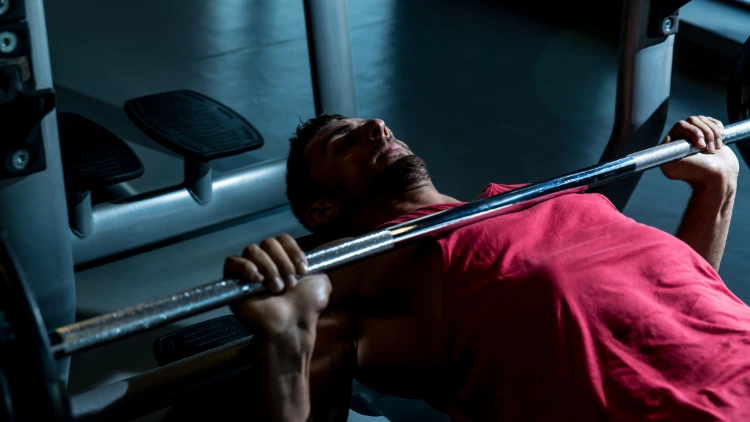
Source: Ibrakovic via Canva.com3
This position typically observed on most elite lifters elicits the most leverage when the pecs, triceps, and delts are recruited—the primary movers of the press. The maximum power can be applied in this part of the ROM, which is eccentric (the muscles are lengthened under the weight load) when the bar is over the nipples.4
Where Should the Bar Touch On Incline Bench Press?
The bar should ideally touch the upper part of the chest slightly below the clavicles (shoulder blades) during the incline bench press.
Where Should the Bar Touch On Decline Bench Press?
During the decline bench press, the bar should touch the lower part of the chest just below the nipples.
Other Factors That Play a Role on Where the Barbell Touches Your Chest
A number of factors will play a role in where the barbell touches the chest. These include the grip width; some may be out of control of the lifter, such as their proportions.
Grip Width
The barbell grip width will always play a dominant role in determining the touch point of the bar. Typically, when the lifter uses a wide grip meaning the distance between the palms is relatively high or wide, the barbell will end up touching marginally higher on the chest. Conversely, when the bar grip is narrow, the elbows will be lower and nearer to the hips, translating into the bar touching slightly lower than the chest.
Individual Proportions: Where Tall People Should Touch the Bar During Bench Press
Individuals have different anatomy, and when it comes to the bench press, the arm length will have a direct correlation with where the barbell will touch the chest. In particular, the size of the humerus, which is the upper bone of the arm between the elbow and shoulder joint.
Lifters with relatively long humerus bones will have their elbows closer to the feet, which means that the barbell will touch lower on the chest. Individuals with short humerus will have the elbow joint closer to the head; as a result, the barbell will touch higher on the chest.
Typical Faults of Bench Press Touching Point
There are several faults on the bench press touching point that will jeopardize the optimal touch point, diminishing the bench press’s effectiveness or, worse, increasing the chances for injury. These include not touching the chest, touching either too high or too low on the chest, and having no consistency in the touch point.
Failure To Touch the Chest
Failure to touch the chest will mean that the primary movers of the bench press will receive inadequate activation due to a decreased ROM. Pressing in a full range of motion will significantly positively affect hypertrophy (muscle growth).5 The pecs and triceps are also the longest when the bar touches the chest.
Touching the Chest Too High
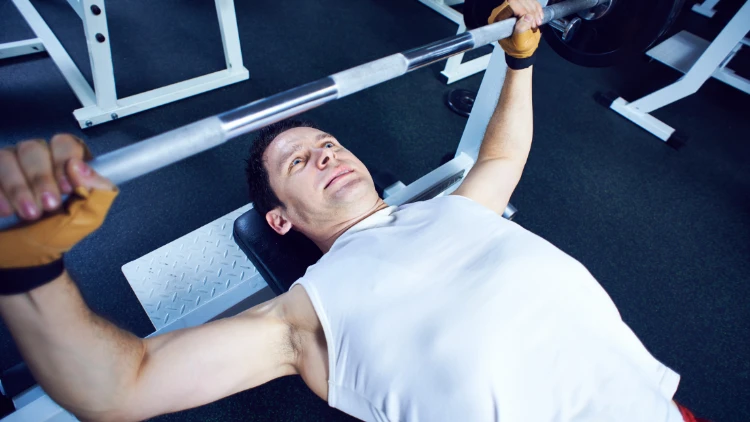
Source: mediaphotos via Canva.com6
The optimal placement for the bar during bench press is crucial. When the barbell touches the chest too high, there will be unnecessary increased stress on the primary movers, increasing the ROM, and placing the shoulder at risk of injury. This usually happens because the elbows are too flared out or tucked in too much towards the torso; both will bring discomfort, signaling something wrong. The solution would be to either tuck elbows or flare elbows, respectively.
Touching the Chest Too Low
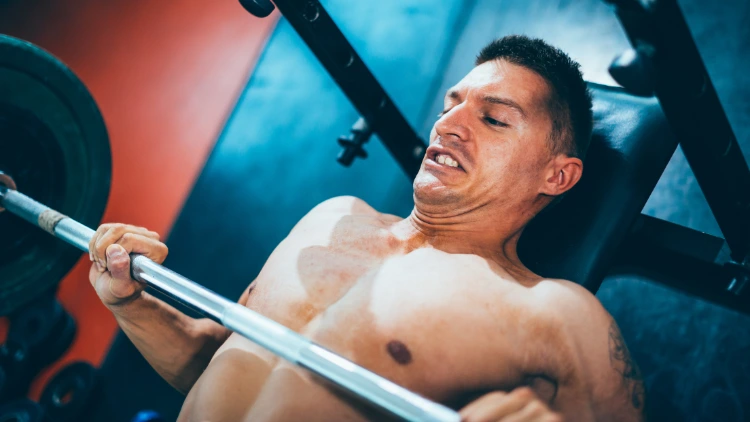
Source: Drazen_ via Canva.com7
Touching the chest too low is also problematic as this will place additional stress on the biceps, delts, and shoulder joints. The press will be inefficient as it will lead to more energy being expended on pressing the bar and also making ROM unnecessarily greater. When the bar is lower than the chest, the biceps and delts need to move it back towards the shoulders for the ascent (moving the bar up).
No Consistency in the Touch Point
There must be consistency in the touch point—the bar must touch at the exact point every time during each successive rep. Failure of this implies no consistency in the technique, which will mean some reps are more demanding than the previous. As a result, the bench becomes inefficient, and there is a reduction in the overall activation of the pecs.
Barbell Being Sunk Into the Chest
The barbell should only touch the chest and not be sunk into it. Doing this often compromises the stability of the torso. This is because shoulder blades may move forward and no longer be pinched, reducing the ultimate tension that needs to be maintained. Pressing from this less stable setup may also make the press more challenging by making the ROM unnecessarily long.
Best Practices When Touching the Bar To Your Chest on the Bench Press
There are best practices that a lifter should follow once they figure out where the bar should touch during bench press in order to ensure optimal technique. These include ensuring the barbell remains motionless on the chest, the bar lightly touches the chest, ensuring that the bar is not bounced off the check, and using video to observe self.
The Barbell Should Be Paused on the Chest
When the lifter touches the bar on the chest, it should proceed to ensure it remains motionless by pausing it on the chest for a second or two. This will increase the time the muscles spend under tension, increasing activation and making them stronger during this lift stage. As a consequence, it will be less challenging to bring the barbell to the correct touch point, thus reinforcing the optimal technique and leading to more gains.
A Light Touch
The bar should touch the chest lightly to ensure that tension and tightness are not lost. It should never be sunk into the chest to ensure the integrity of the arch remains, and the shoulders are firmly pinched.
Lowering the Bar With a Controlled Range of Motion
The lifter should take care never to bounce the barbell off the chest touch point. They should lower the bar and touch the bar on the chest in a controlled manner. This will ensure that the technique remains consistent and that ROM does not alter.
Using Chalk to Gauge Consistently in Touch Point
It will be a great idea to rub chalk on the side of the barbell that will be touching the chest, which will lead to a clear marking on the chest whenever the bar touches the chest. This will provide excellent feedback to gauge whatever drifts the lifter may have.
Using Video To Self-Improve
Using video to record the bench press at different angles, analyze the bar’s speed and the bar path being taken, and also gauge the lifter’s set up crucial to stability. This will enable a man or woman lifter to correct whatever deficiencies they may have. Coach’s eye is a smartphone app that can help a lifter analyze footage taken during an exercise.
Should You Touch Your Chest on Bench Press?
It’s common to see gym goers stopping the bar up to 6 inches above their chest, however, the bar should always touch the chest in a bench press to fully complete the movement and maximize the benefits of the lift.
Why You Should Touch the Chest on the Barbell Bench Press
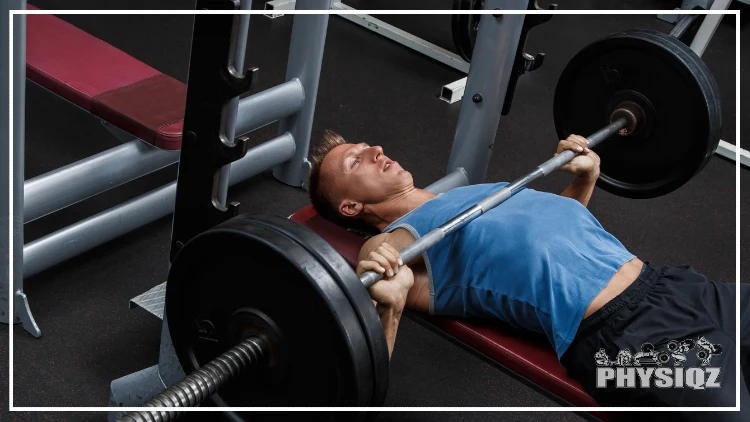
Source: A’s Images via Canva.com8
When the bar doesn’t touch the chest, a full range of motion (ROM) is not being performed, denying the pecs more activation and stimulation—these reps don’t count as complete reps. In addition, in powerlifting, lifters must touch and pause at the chest for the lift to count.
As the bar touches the chest, the bench press is now executed with maximum excretion; that is, it is a strength-oriented lift which is why it has to touch the chest. Dumbbells are better used to experiment with varying ROM.
There are some cases where partial bench presses are ‘allowed’ to increase the time under tension to maximize blood flow, as in the case of elite bodybuilders.9 Powerlifter may also be working on a sticking point—the point where the lift becomes significantly tricky—to improve their overall press.10 Since most lifters are not in either of these categories, they should keep touching the chest.
In summary, the reasons why you should touch your chest on the bench press are as follows:
Range of motion (ROM)—touching the bar on the chest ensures that a full range of motion is achieved which will result in the maximum activation of the primary movers due to the increased engagement of the muscle fibers.
Tension in the eccentric—when the bar touches the chest, the pec muscles are in the eccentric, which means they are lengthened under load and are at the maximum; this ensures adequate tension. When there is a pause, this increased time under tension will make the primary movers more efficient as they are getting stronger at this stage in the lift; thus allowing the lifter to have more control of the bar.
Mitigate the risks of injury—the optimal range of motion will ensure less stress on the shoulder joint and reduce the risk of injury since more fibers will be recruited from the pecs.
Strengthening Connective Tissues and Bones—when the bar touches the chest, there is a full ROM that will strengthen the joints and increase bone mass.
How To Constantly Touch The Bar on Your Chest in the Right Place
To ensure that the bar constantly touches the bar on the chest in the right place, the lifter must adhere to some guidelines as to where should the bar be touched on the bench press. These include:
Ensuring a normal grip— the wrist should always be neutral and the normal grip should not be too wide such that the bar ends up on the upper part of the chest and not narrow so the bar ends on the lower part of the chest. While anatomy will play a part here, the lifter may try out which is the most ideal grip width that will lead to an optimal touchpoint by ensuring a proper bar placement and reducing the risk of injury—a wide grip width of 1.5 times the shoulder width increases the risk for injury.11 Heavy presses can include the use of wrist wraps as well to ensure wrist form isn’t compromised.
Having the optimal setup—ensuring a solid base is set up by having the feet flat and firmly planted on the ground. The back will need to be arched and the shoulder blades squeezed together with the upper back driven into the bench to position the bar for bench press; this should give the lifter a firm tense base to drive the bar with supreme control.
Attention to be paid to the elbows—the elbows should not be too tucked to the torso, which will place more stress on the triceps; in this case, they should be flared in more. If they are too flared out, they will cause unnecessary stress on the shoulder joint and should be tucked in more. Over flaring or over-tucking will lead to the bar landing incorrectly. Due to differing anatomies, the lifter should experiment to find an angle between 45 and 70 degrees that works for them—for reference, 90 degrees is the angle between shoulder and torso.
Lifters wondering where the bar should touch during bench press will find it beneficial to optimize their bench press by ensuring an ideal and consistent chest touch point; it is not on your chest as is often misinterpreted.
References
1gilaxia. “Bench press workout.” Canva, 14 March 2023. Accessed 11 April 2023. <https://www.canva.com/photos/MAEJMOyx2OY-bench-press-workout-/>
2Medicine, N. L. (2017, April 20). Effect of Barbell Weight on the Structure of the Flat Bench Press. Retrieved 2022, from <https://www.ncbi.nlm.nih.gov/pmc/articles/PMC5400411/>
3Ibrakovic. “Bench press at gym.” Canva. Accessed 11 April 2023. <https://www.canva.com/photos/MADAZJKi0Ss-bench-press-at-gym/>
4Wikipedia. (2022, May 16). Eccentric training. Retrieved 2022, from <https://en.wikipedia.org/wiki/Eccentric_training>
5Medicine, N. L. (2022, January 1). Bench Press at Full Range of Motion Produces Greater Neuromuscular Adaptations Than Partial Executions After Prolonged Resistance Training. Retrieved 2022, from <https://pubmed.ncbi.nlm.nih.gov/31567719/>
6mediaphotos. “Bench press.” Canva. Accessed 11 April 2023. <https://www.canva.com/photos/MAEJdGroIxs-bench-press/>
7Drazen_. “Bench press exercise in gym.” Canva. Accessed 11 April 2023. <https://www.canva.com/photos/MAEJMKB5w5Y-bench-press-exercise-in-gym/>
8A’s Images. “Man during bench press exercise.” Canva, 14 March 2023. Accessed 11 April 2023. <https://www.canva.com/photos/MAE3Xh4vu-c-man-during-bench-press-exercise/>
9Medicine, N. L. (2011, November 21). Muscle time under tension during resistance exercise stimulates differential muscle protein sub-fractional synthetic responses in men. Retrieved 2022, from <https://www.ncbi.nlm.nih.gov/pmc/articles/PMC3285070/>
10Medicine, N. L. (2016, January 12). Understanding and Overcoming the Sticking Point in Resistance Exercise. Retrieved 2022, from <https://www.ncbi.nlm.nih.gov/pmc/articles/PMC4887540/>
11Green, C. M., & Comfort, P. M. (2007). The Affect of Grip Width on Bench Press Performance and Risk of Injury. Retrieved 2022, from <https://www.researchgate.net/publication/232096734_The_Affect_of_Grip_Width_on_Bench_Press_Performance_and_Risk_of_Injury>